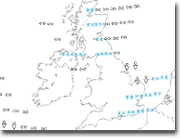Description:
 |
Rain or shower?
This chart
shows the kind of precipitation that is likely to fall given the
atmospheric
and surface conditions at a certain place. The following table explains the symbols: |
| Precipitation | Light | Moderate | Heavy | |
| Rain |  |
 |
 |
|
| Rain shower |  |
 |
 |
|
| Snow |  |
 |
 |
|
| Snow shower |  |
 |
 |
|
| Sleet |  |
 |
 |
|
| Freezing rain |  |
 |
 |
|
| Cloud Cover | 0-2 | 3-4 | 5-7 | 8 |
| (eights) |  |
 |
 |
 |